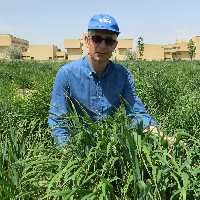Identification of Effective Traits on Forage Yield in Tall Fescue(Festuca Arundinacea Schreb.)
Introduction of high yielding forage cultivars for different climates is necessary to use in pasture establishment and rangeland renovation. Thus, increasing forage yield is one of the most important goals in cool-season grass breeding programs. Tall fescue (Festuca Arundinacea Schreb.) is a perennial cool-season grass adapted to a wide range of growing conditions. Tall fescue is one of the most drought, heat, and wear tolerant species among perennial cool-season grasses. Due to its large and deep root system, it is able to take up water in dry periods when other grasses have stopped their growth. Then it could be a good choice for pasture establishment and rangeland renovation in Iran. This study was carried out to identify important traits which are effective to increase forage yield in the tall fescue in East Azarbaijan region of Iran.
For this purpose, 32 tall fescue genotypes were evaluated in a randomized complete block design (RCBD) with 4 replications in research farm of Agricultural Biotechnology Research Institute of Northwest and West region of Iran- Tabriz in 2016. Each replication contained 5 spaced single plants 60 cm apart. Eleven agro-morphological characteristics were measured.
The correlation coefficients showed that total dry forage yield and seed yield had significant and positive correlation with all traits except days to heading and days to pollination. Total dry forage yield had significant and positive correlation with plant height, canopy diameter, stem number, and crown diameter (0.650**, 0.763**, 0.500**, and 0.750**, respectively). Stepwise regression analysis, considering the total dry forage yield as the dependent variable, showed that canopy diameter and crown diameter were entered into the model. These traits in total justified 64.1 percent of the regression model changed. Moreover, stepwise regression analysis, considering the seed yield as the dependent variable, showed that total dry forage yield, stem number, and canopy diameter were entered into the model. According to the results, canopy diameter (0.453) and crown diameter (0.394) had highest direct effects on the total dry forage yield and for the seed yield, total dry forage yield (0.797) and stem number (0.423) had highest direct effects.
Based on the results of this study, canopy diameter and crown diameter had greater relative importance in determining the total dry forage yield of tall fescue. Thus, plant canopy and crown diameter cold be used as an indicator in selection of best tall fescue genotypes in breeding programs.
- حق عضویت دریافتی صرف حمایت از نشریات عضو و نگهداری، تکمیل و توسعه مگیران میشود.
- پرداخت حق اشتراک و دانلود مقالات اجازه بازنشر آن در سایر رسانههای چاپی و دیجیتال را به کاربر نمیدهد.




